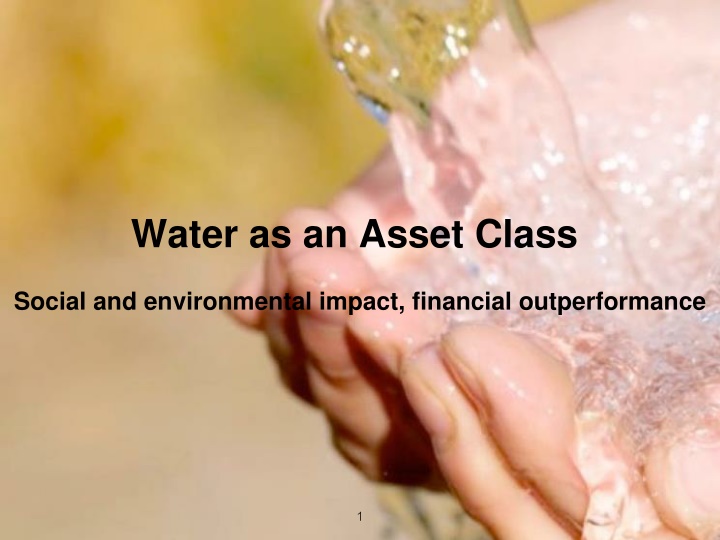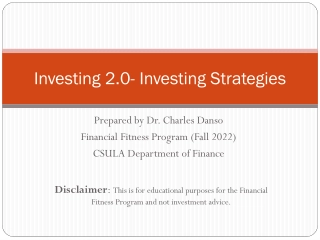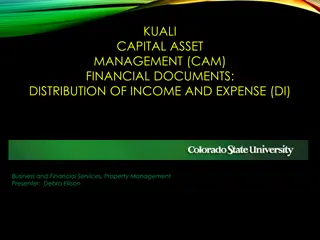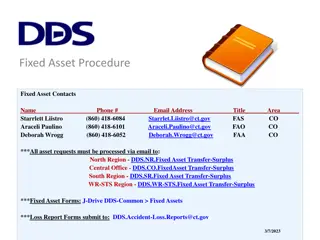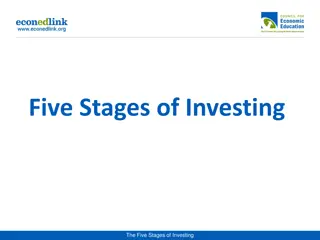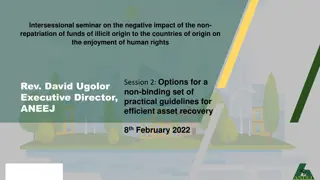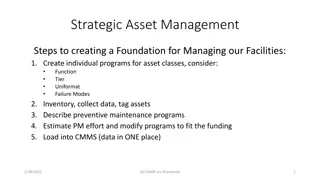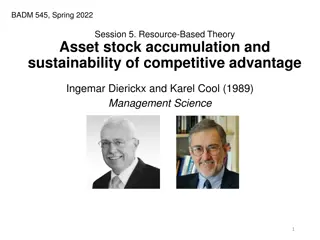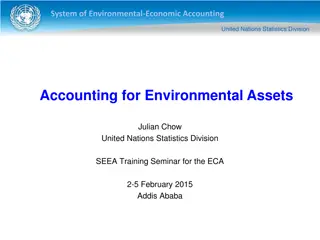Investing in Water: A Compelling Asset Class with Social, Environmental, and Financial Impact
Fresh water scarcity is a pressing global issue driving the investment potential in water-related companies. With increasing demand and limited supply, opportunities emerge for investors to support water infrastructure projects and innovative solutions. Despite water covering over 70% of the Earth, only a small portion is safe for consumption. The growing population, climate change effects, and water-intensive agriculture highlight the urgency for sustainable water management and investment in addressing water challenges.
Download Presentation

Please find below an Image/Link to download the presentation.
The content on the website is provided AS IS for your information and personal use only. It may not be sold, licensed, or shared on other websites without obtaining consent from the author.If you encounter any issues during the download, it is possible that the publisher has removed the file from their server.
You are allowed to download the files provided on this website for personal or commercial use, subject to the condition that they are used lawfully. All files are the property of their respective owners.
The content on the website is provided AS IS for your information and personal use only. It may not be sold, licensed, or shared on other websites without obtaining consent from the author.
E N D
Presentation Transcript
Water as an Asset Class Social and environmental impact, financial outperformance 1
Water a compelling investment story Fresh water has no substitute - and only a fraction of today s supply is safe for consumption. Given a fast-growing world popula A flood of opportunity Water is currently a $500 billion market that could grow to as much as $1 trillion by 2020 Investments are needed along the entire water-value chain; global water-infrastructure projects alone are expected to see annual Companies that focus on addressing the increasing demand for and limited supply of water could represent some of the world s Water as an Asset Class I expect to see a globally integrated market for fresh water within 25 to 30 years. Once the spot markets for water are integrated, futures markets and other derivative water Willem Buiter, Global Chief Economist, Citigroup (2011) 2
Opportunity Flows: Investing in water-related companies In a world that s more than 70% covered by water, where many people enjoy a never-ending stream of clean water that s a mere twist of the tap away, it can be hard to imagine any kind of water scarcity. Yet for a growing part of the world s population-from wealthy residents in dry regions of developed nations to the urban poor in emerging economies-limits on supply and increasing demand are creating an ever-greater global water challenge. Solving this problem demands a long-term effort from institutions around the world and will require significant investment from the private sector. Limited Supply There is no substitute for fresh, clean water. Other commodities have their surrogates - wheat for oats, coal for natural gas - but water does not. Yet this vital natural resource is not quite as abundant as some might think. Approximately 97% of the world s water is non- potable seawater, and most of the freshwater is contained in the polar ice caps. The rest - found in rivers, lakes and aquifers- can be hard to access, is being increasingly placed at risk by climate change and can easily be made unusable by contamination. All told, less than 0.007% of all the water in the world is potable, or safe for consumption, according to the World Health Organization. Rising Demand At the same time, demand for fresh water is steadily increasing. The world s population is growing rapidly and climate change is causing shifts in rainfall levels and overall water availability - exacerbating what is already an enormous economic and social challenge: getting a secure supply of usable water to the billions of people and countless businesses that depend on it every day. A Worsening Situation So where does all the water go? While energy production, manufacturing and basic hygiene needs account for a large part of the demand, the vast majority - approximately 70% of all the world s freshwater resources - is used for agriculture. The enormous amount of water needed to grow the crops and livestock that feed and clothe the world s population has helped create a dire situation. According to the U.N., more than 1.6 billion people are currently living in places where sustainable water use has already reached its limits. These areas include both emerging economies and developed regions. The U.N. believes that by 2025, two-thirds of the world s population will live in these water-stressed areas. 3
Water index attributes As economies across the world expand, the demand for water and ancillary services continues to rise. The S&P Global Water 4
Equity Ethical - Social and environmental impact, financial outperformance 5
Meeting the water challenge To address these and many other water-related issues, the public and private sectors are looking for ways to simultaneously increase supply and reduce demand. It s a significant challenge in a world where the population is skyrocketing, the climate is changing, and developing and established nations are in increasing competition over the same resources. These factors are reasons why water is an enormous issue being addressed by some of the world s most powerful institutions, including the United Nations and the World Economic Forum. As a result of this increased focus on water, Nestle, Pepsi, Gap, Nike, Chevron and Dow are among the major corporations that have launched significant water initiatives to better manage their water usage, boost their profitability and help their communities. Many other companies have branched out into new technologies related to water for purely profit-related reasons. General Electric s infrastructure unit purchased Ionics, a global water services provider; Siemens purchased U.S. Filter s water systems and services businesses; and ITT Corporation purchased Xylem, a company focused solely on water technology. Other notable deals include Ecolab, which bought Nalco Holding, a waste- and water- treatment company, for $5.4 billion; and Cheung Kong Infrastructure Holdings, which bought Northumbrian Water, a supplier of water and wastewater services, for $3.9 billion. Yet even as these major institutions are looking for ways to solve the growing water problem, there are increasing constraints being placed upon local and state governments, which must comply with increased federal regulations that require upgrades to their water systems. Meanwhile, with the existing water infrastructure in the US and Europe approaching the end of its useful timeline, and with emerging markets continuously building out what is still a fairly basic water-supply network, the demand for water infrastructure technology is increasing. The intersection of these vital human needs with critical physical restraints is prompting an increasing demand for the kinds of large-scale projects and daily-use innovations that may result in attractive investment opportunities across the entire water supply. 6
Investment opportunities along the water chain With a growing need for clean water, and with polluted water becoming a serious economic issue, governments and corporations Three investment opportunities in water-related companies Three main areas to which governments and private corporations will have to devote substantial resources to help solve the growing water challenge. Each one provides a range of attractive water-related investment opportunities. 7
Water has outperformed the broader equity markets Water has outperformed the broader equity markets Water boasts a favorable risk/reward profile Since 2004, water has provided significantly higher returns than stocks and bonds, with less volatility than most traditional equity indexes. A hypothetical $1,000 investment in the S&P Global Water Index at inception (11/16/2001) would have grown 344% far outpacing broader stock-market indexes. 8
Water, a dynamic, diversified asset class Contrary to the belief held by some investors and market-watchers, the water segment is not limited to water utilities, but is instead diversified across a number of industries and regions. The S&P Global Water Index is composed of 50 of the largest pub The case for active management While passive exchange-traded funds (ETFs) and mutual funds are gaining acceptance as efficient ways to access many asset class Unlike passive ETFs, active managers may: Be proactive, taking a strategic view of the issues facing and shaping the industry. They can seek out companies where new pr Exercise flexibility to invest beyond pure-play water companies, in which the main focus of the company s business activity is water 9
Water sector provides a strong complement to a core equity allocation Strategically allocating to water investments within an overall equity position may offer an incrementally higher return thanks to the sector s reasonably high correlation with traditional equity segments. 10
Opportunity summary Increasing privatization Although the public sector currently rules the water industry in most of the world - with water and sanitation infrastructure requiring $11.7 trillion in global investment through 2030 - and with public funding already under substantial financial pressure, it s likely that the private sector will play a greater role in funding water investments.In the next three to five years, the private sector is expected to account for 30% of water investments. Europe has already started to make the transition into privatization of water management, and the majority of services for the UK and France are handled by private operators. We believe this trend is likely to continue globally, which will have significant implications for the investment landscape. Water is a compelling business model Because of global population growth, demand for clean, fresh water continues to increase - unaffected by economic conditions, political developments or ever-changing consumer preferences. We view the sector as a long-term investment opportunity that has historically offered stable, consistent returns and can serve as an alternative to low-yielding bonds and volatile equity markets. Drivers of water investing Given the scale of the global water problem and the fact that water infrastructure is extremely costly and capital intensive, requiring years of careful planning, it is not surprising that water is increasingly viewed as a core commodity that is potentially as profitable as oil. We have identified three main drivers of opportunities in the water space. Consistent long-term growth potential Water investing has the potential to offer strong, long-term, consistent growth potential in a wide range of market or economic environments. Since its inception, the S&P Global Water Index has grown by over 300% and has outperformed broader equity-market indexes - including the S&P 500 Index, which it beat by over 4.8% on an annualized basis from 11/2001 to 12/2015. The water segment has historically provided an attractive risk/reward profile when compared to more traditional asset classes, offering significant income potential and volatility that is in line with, or less than, other equity indexes. 12
Thomas Schumann Capital LLC The Water The Garden 2425 Olympic Blvd., S. 4000W, Santa Monica, CA 90404, U.S.A. www.thomasschumann.com 13
Endnotes, Sources, Credentials: : 2030 Water Resources Group, World Health Organization Footprints and Milestones: Population and EnvironmentalChange,The State of World Population 2001, United Nations Population Fund, United Nations, Shiklomanov and Rodda, 2003,Bank of America SRI Report, Sept.2011,WorldBank, Solutions for a water-short world, Hinrichsen, D., Robey, B.,and Upadhyay, U.D. Population Reports, Series M,No.14.Johns Hopkins School of Public Health, Population Information Program, Dec. 1997, UNDP Human Development Report; Beyond scarcity: Power, poverty and the global water crisis, Nov. 9, 2006, Financing Water for All: Report of the World Panel on Financing Global Water Infrastructure,World Water Council, 2001 BofA Merrill Lynch, World Bank, EPA, Allianz Global Investors Distributors LLC, 1633 Broadway, New York, NY, 10019-7585 14
